CNA613 Project Management Plan: Risk Analysis and Risk Register
VerifiedAdded on 2019/10/09
|26
|6828
|196
Project
AI Summary
This document presents a comprehensive Project Management Plan (PMP) designed for Assessment 3 of the CNA613 unit. The plan serves as a hypothetical project, focusing on the submission of the PMP and its appendices, rather than execution. It includes an executive summary, project overview, scope definition (problem statement, goal, objectives, outcomes, and deliverables), work breakdown structure, project management office structure, communication and stakeholder management plans, human resources and cost management plans, a risk management plan, and a quality management plan. The appendices contain a work breakdown structure with a Gantt chart, a project budget, and a detailed risk analysis with a risk register. The PMP emphasizes clear communication, stakeholder engagement, and effective risk mitigation strategies, providing a structured approach to project management and ensuring the successful delivery of defined project objectives.
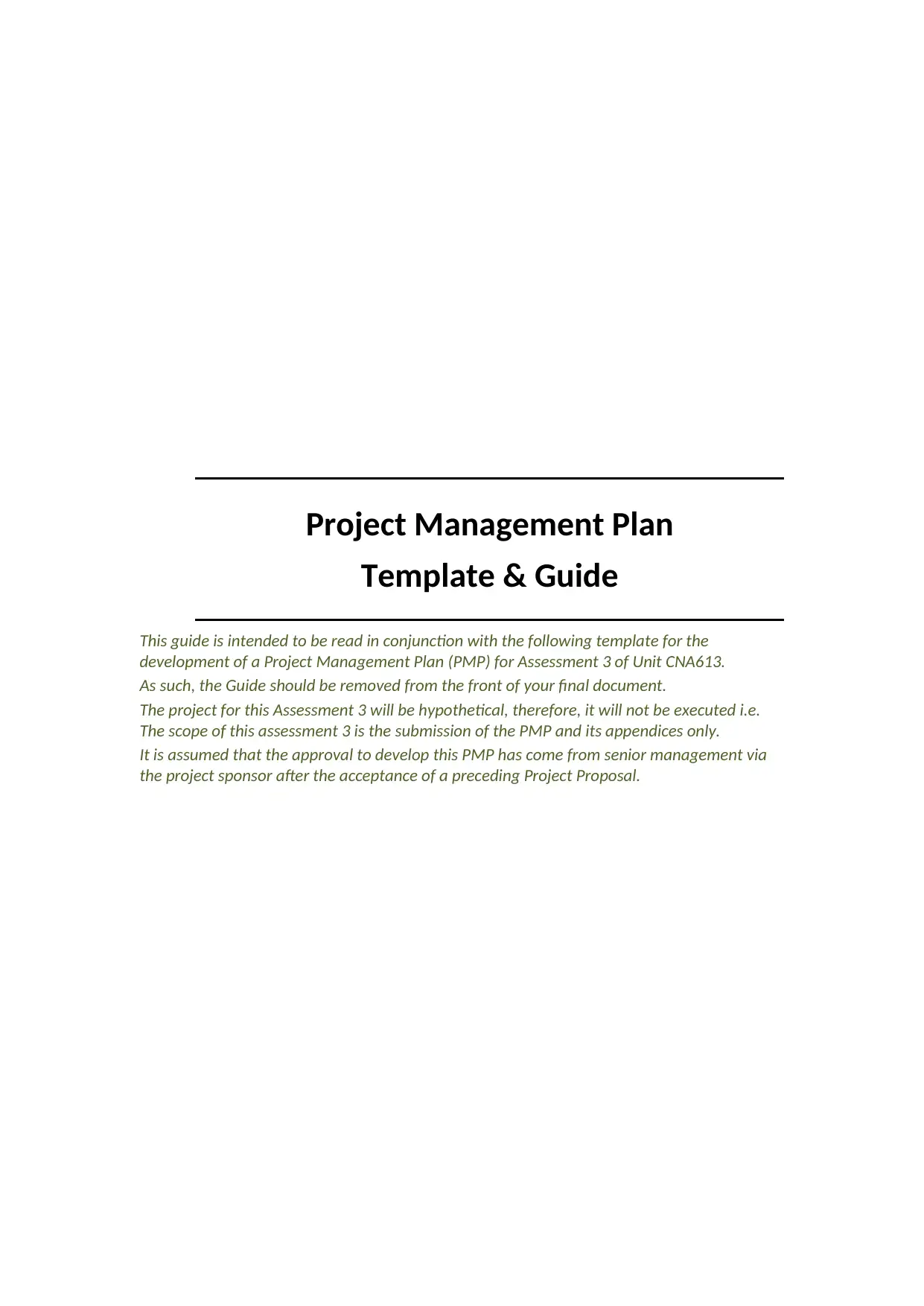
Project Management Plan
Template & Guide
This guide is intended to be read in conjunction with the following template for the
development of a Project Management Plan (PMP) for Assessment 3 of Unit CNA613.
As such, the Guide should be removed from the front of your final document.
The project for this Assessment 3 will be hypothetical, therefore, it will not be executed i.e.
The scope of this assessment 3 is the submission of the PMP and its appendices only.
It is assumed that the approval to develop this PMP has come from senior management via
the project sponsor after the acceptance of a preceding Project Proposal.
Template & Guide
This guide is intended to be read in conjunction with the following template for the
development of a Project Management Plan (PMP) for Assessment 3 of Unit CNA613.
As such, the Guide should be removed from the front of your final document.
The project for this Assessment 3 will be hypothetical, therefore, it will not be executed i.e.
The scope of this assessment 3 is the submission of the PMP and its appendices only.
It is assumed that the approval to develop this PMP has come from senior management via
the project sponsor after the acceptance of a preceding Project Proposal.
Paraphrase This Document
Need a fresh take? Get an instant paraphrase of this document with our AI Paraphraser
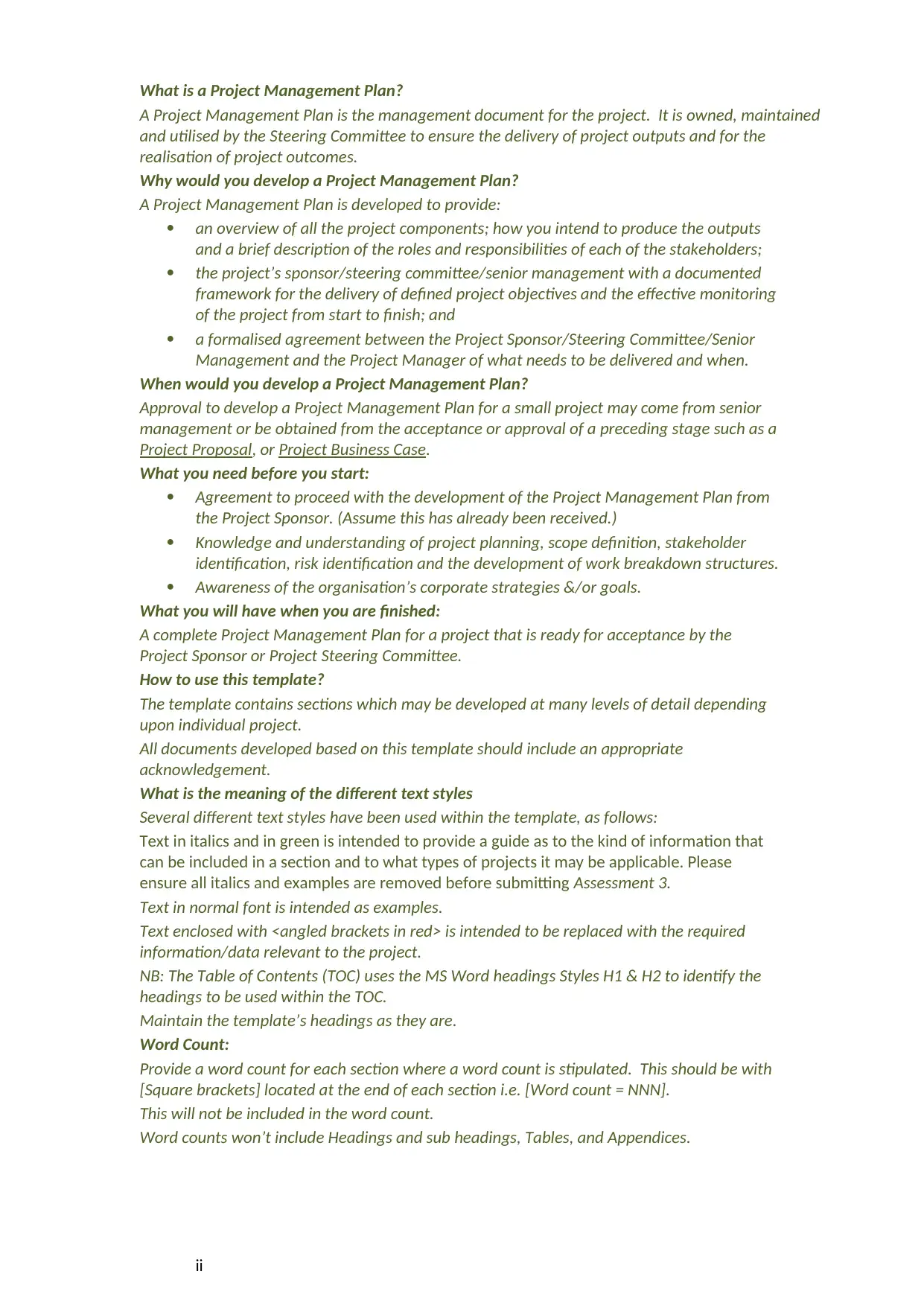
What is a Project Management Plan?
A Project Management Plan is the management document for the project. It is owned, maintained
and utilised by the Steering Committee to ensure the delivery of project outputs and for the
realisation of project outcomes.
Why would you develop a Project Management Plan?
A Project Management Plan is developed to provide:
an overview of all the project components; how you intend to produce the outputs
and a brief description of the roles and responsibilities of each of the stakeholders;
the project’s sponsor/steering committee/senior management with a documented
framework for the delivery of defined project objectives and the effective monitoring
of the project from start to finish; and
a formalised agreement between the Project Sponsor/Steering Committee/Senior
Management and the Project Manager of what needs to be delivered and when.
When would you develop a Project Management Plan?
Approval to develop a Project Management Plan for a small project may come from senior
management or be obtained from the acceptance or approval of a preceding stage such as a
Project Proposal, or Project Business Case.
What you need before you start:
Agreement to proceed with the development of the Project Management Plan from
the Project Sponsor. (Assume this has already been received.)
Knowledge and understanding of project planning, scope definition, stakeholder
identification, risk identification and the development of work breakdown structures.
Awareness of the organisation’s corporate strategies &/or goals.
What you will have when you are finished:
A complete Project Management Plan for a project that is ready for acceptance by the
Project Sponsor or Project Steering Committee.
How to use this template?
The template contains sections which may be developed at many levels of detail depending
upon individual project.
All documents developed based on this template should include an appropriate
acknowledgement.
What is the meaning of the different text styles
Several different text styles have been used within the template, as follows:
Text in italics and in green is intended to provide a guide as to the kind of information that
can be included in a section and to what types of projects it may be applicable. Please
ensure all italics and examples are removed before submitting Assessment 3.
Text in normal font is intended as examples.
Text enclosed with <angled brackets in red> is intended to be replaced with the required
information/data relevant to the project.
NB: The Table of Contents (TOC) uses the MS Word headings Styles H1 & H2 to identify the
headings to be used within the TOC.
Maintain the template’s headings as they are.
Word Count:
Provide a word count for each section where a word count is stipulated. This should be with
[Square brackets] located at the end of each section i.e. [Word count = NNN].
This will not be included in the word count.
Word counts won’t include Headings and sub headings, Tables, and Appendices.
ii
A Project Management Plan is the management document for the project. It is owned, maintained
and utilised by the Steering Committee to ensure the delivery of project outputs and for the
realisation of project outcomes.
Why would you develop a Project Management Plan?
A Project Management Plan is developed to provide:
an overview of all the project components; how you intend to produce the outputs
and a brief description of the roles and responsibilities of each of the stakeholders;
the project’s sponsor/steering committee/senior management with a documented
framework for the delivery of defined project objectives and the effective monitoring
of the project from start to finish; and
a formalised agreement between the Project Sponsor/Steering Committee/Senior
Management and the Project Manager of what needs to be delivered and when.
When would you develop a Project Management Plan?
Approval to develop a Project Management Plan for a small project may come from senior
management or be obtained from the acceptance or approval of a preceding stage such as a
Project Proposal, or Project Business Case.
What you need before you start:
Agreement to proceed with the development of the Project Management Plan from
the Project Sponsor. (Assume this has already been received.)
Knowledge and understanding of project planning, scope definition, stakeholder
identification, risk identification and the development of work breakdown structures.
Awareness of the organisation’s corporate strategies &/or goals.
What you will have when you are finished:
A complete Project Management Plan for a project that is ready for acceptance by the
Project Sponsor or Project Steering Committee.
How to use this template?
The template contains sections which may be developed at many levels of detail depending
upon individual project.
All documents developed based on this template should include an appropriate
acknowledgement.
What is the meaning of the different text styles
Several different text styles have been used within the template, as follows:
Text in italics and in green is intended to provide a guide as to the kind of information that
can be included in a section and to what types of projects it may be applicable. Please
ensure all italics and examples are removed before submitting Assessment 3.
Text in normal font is intended as examples.
Text enclosed with <angled brackets in red> is intended to be replaced with the required
information/data relevant to the project.
NB: The Table of Contents (TOC) uses the MS Word headings Styles H1 & H2 to identify the
headings to be used within the TOC.
Maintain the template’s headings as they are.
Word Count:
Provide a word count for each section where a word count is stipulated. This should be with
[Square brackets] located at the end of each section i.e. [Word count = NNN].
This will not be included in the word count.
Word counts won’t include Headings and sub headings, Tables, and Appendices.
ii
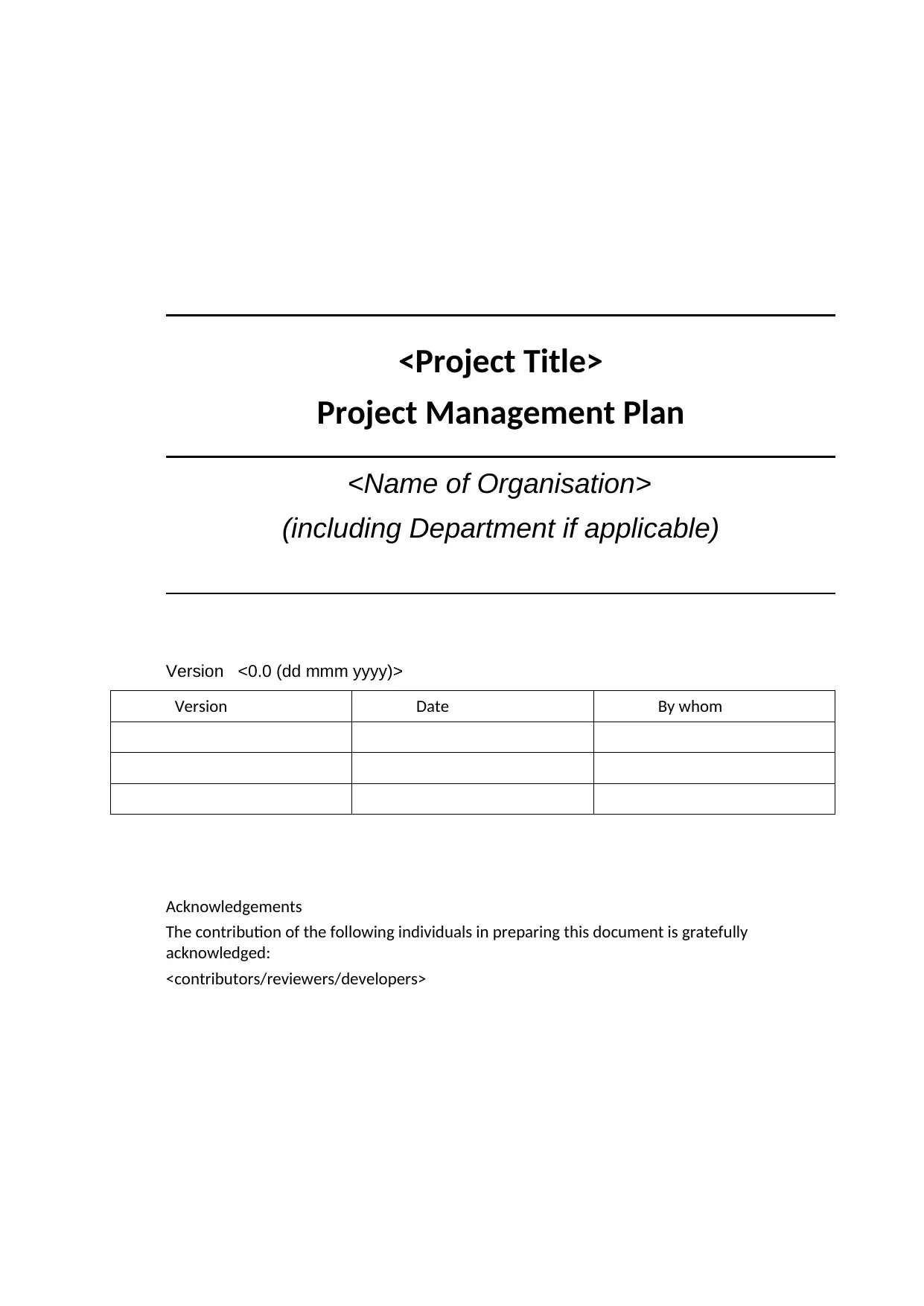
<Project Title>
Project Management Plan
<Name of Organisation>
(including Department if applicable)
Version <0.0 (dd mmm yyyy)>
Version Date By whom
Acknowledgements
The contribution of the following individuals in preparing this document is gratefully
acknowledged:
<contributors/reviewers/developers>
Project Management Plan
<Name of Organisation>
(including Department if applicable)
Version <0.0 (dd mmm yyyy)>
Version Date By whom
Acknowledgements
The contribution of the following individuals in preparing this document is gratefully
acknowledged:
<contributors/reviewers/developers>
⊘ This is a preview!⊘
Do you want full access?
Subscribe today to unlock all pages.

Trusted by 1+ million students worldwide
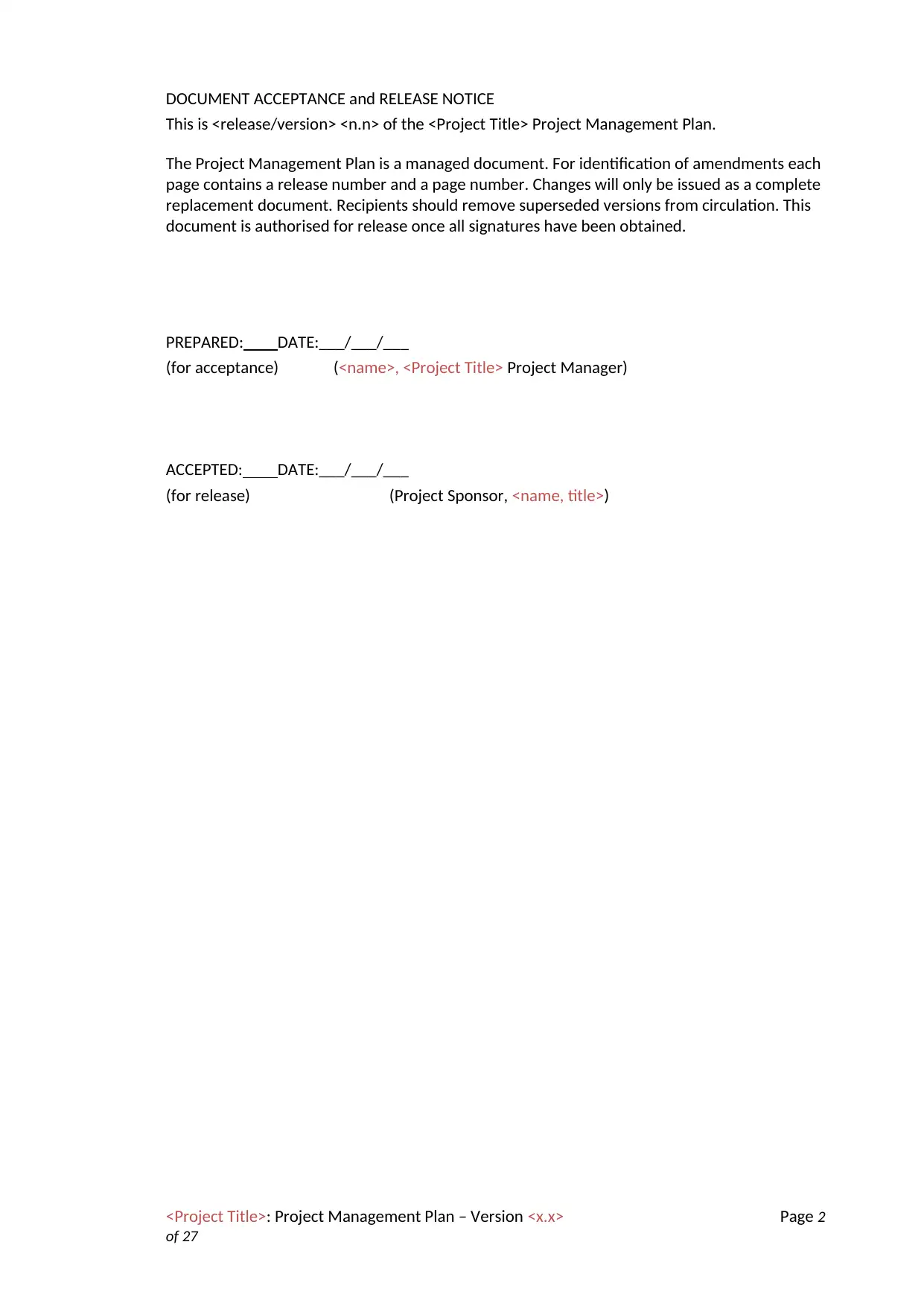
DOCUMENT ACCEPTANCE and RELEASE NOTICE
This is <release/version> <n.n> of the <Project Title> Project Management Plan.
The Project Management Plan is a managed document. For identification of amendments each
page contains a release number and a page number. Changes will only be issued as a complete
replacement document. Recipients should remove superseded versions from circulation. This
document is authorised for release once all signatures have been obtained.
PREPARED: DATE:___/___/___
(for acceptance) (<name>, <Project Title> Project Manager)
ACCEPTED: DATE:___/___/___
(for release) (Project Sponsor, <name, title>)
<Project Title>: Project Management Plan – Version <x.x> Page 2
of 27
This is <release/version> <n.n> of the <Project Title> Project Management Plan.
The Project Management Plan is a managed document. For identification of amendments each
page contains a release number and a page number. Changes will only be issued as a complete
replacement document. Recipients should remove superseded versions from circulation. This
document is authorised for release once all signatures have been obtained.
PREPARED: DATE:___/___/___
(for acceptance) (<name>, <Project Title> Project Manager)
ACCEPTED: DATE:___/___/___
(for release) (Project Sponsor, <name, title>)
<Project Title>: Project Management Plan – Version <x.x> Page 2
of 27
Paraphrase This Document
Need a fresh take? Get an instant paraphrase of this document with our AI Paraphraser
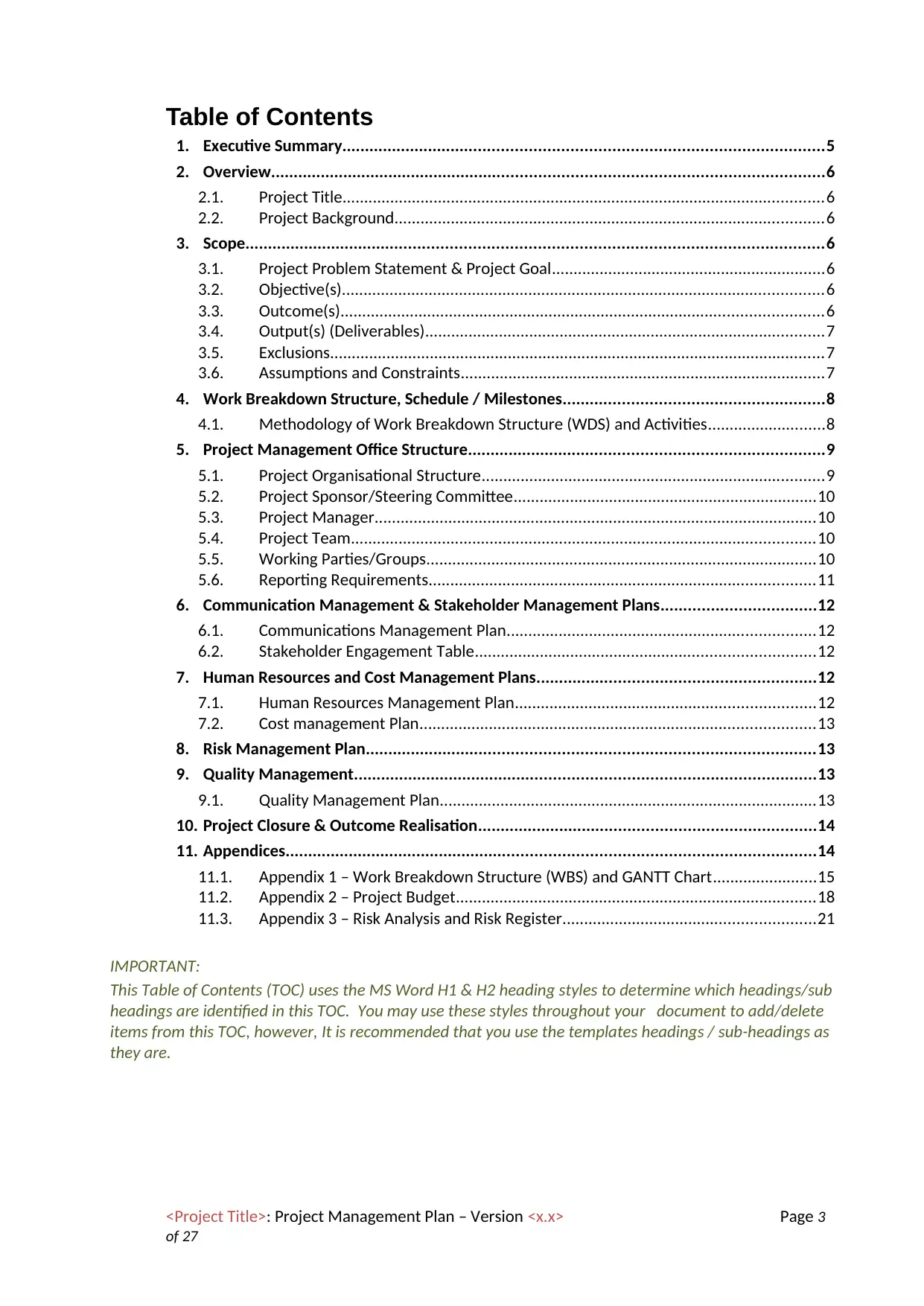
Table of Contents
1. Executive Summary.........................................................................................................5
2. Overview.........................................................................................................................6
2.1. Project Title...............................................................................................................6
2.2. Project Background...................................................................................................6
3. Scope..............................................................................................................................6
3.1. Project Problem Statement & Project Goal...............................................................6
3.2. Objective(s)...............................................................................................................6
3.3. Outcome(s)...............................................................................................................6
3.4. Output(s) (Deliverables)............................................................................................7
3.5. Exclusions..................................................................................................................7
3.6. Assumptions and Constraints....................................................................................7
4. Work Breakdown Structure, Schedule / Milestones.........................................................8
4.1. Methodology of Work Breakdown Structure (WDS) and Activities...........................8
5. Project Management Office Structure..............................................................................9
5.1. Project Organisational Structure...............................................................................9
5.2. Project Sponsor/Steering Committee......................................................................10
5.3. Project Manager......................................................................................................10
5.4. Project Team...........................................................................................................10
5.5. Working Parties/Groups..........................................................................................10
5.6. Reporting Requirements.........................................................................................11
6. Communication Management & Stakeholder Management Plans..................................12
6.1. Communications Management Plan.......................................................................12
6.2. Stakeholder Engagement Table..............................................................................12
7. Human Resources and Cost Management Plans.............................................................12
7.1. Human Resources Management Plan.....................................................................12
7.2. Cost management Plan...........................................................................................13
8. Risk Management Plan..................................................................................................13
9. Quality Management.....................................................................................................13
9.1. Quality Management Plan.......................................................................................13
10. Project Closure & Outcome Realisation..........................................................................14
11. Appendices....................................................................................................................14
11.1. Appendix 1 – Work Breakdown Structure (WBS) and GANTT Chart........................15
11.2. Appendix 2 – Project Budget...................................................................................18
11.3. Appendix 3 – Risk Analysis and Risk Register..........................................................21
IMPORTANT:
This Table of Contents (TOC) uses the MS Word H1 & H2 heading styles to determine which headings/sub
headings are identified in this TOC. You may use these styles throughout your document to add/delete
items from this TOC, however, It is recommended that you use the templates headings / sub-headings as
they are.
<Project Title>: Project Management Plan – Version <x.x> Page 3
of 27
1. Executive Summary.........................................................................................................5
2. Overview.........................................................................................................................6
2.1. Project Title...............................................................................................................6
2.2. Project Background...................................................................................................6
3. Scope..............................................................................................................................6
3.1. Project Problem Statement & Project Goal...............................................................6
3.2. Objective(s)...............................................................................................................6
3.3. Outcome(s)...............................................................................................................6
3.4. Output(s) (Deliverables)............................................................................................7
3.5. Exclusions..................................................................................................................7
3.6. Assumptions and Constraints....................................................................................7
4. Work Breakdown Structure, Schedule / Milestones.........................................................8
4.1. Methodology of Work Breakdown Structure (WDS) and Activities...........................8
5. Project Management Office Structure..............................................................................9
5.1. Project Organisational Structure...............................................................................9
5.2. Project Sponsor/Steering Committee......................................................................10
5.3. Project Manager......................................................................................................10
5.4. Project Team...........................................................................................................10
5.5. Working Parties/Groups..........................................................................................10
5.6. Reporting Requirements.........................................................................................11
6. Communication Management & Stakeholder Management Plans..................................12
6.1. Communications Management Plan.......................................................................12
6.2. Stakeholder Engagement Table..............................................................................12
7. Human Resources and Cost Management Plans.............................................................12
7.1. Human Resources Management Plan.....................................................................12
7.2. Cost management Plan...........................................................................................13
8. Risk Management Plan..................................................................................................13
9. Quality Management.....................................................................................................13
9.1. Quality Management Plan.......................................................................................13
10. Project Closure & Outcome Realisation..........................................................................14
11. Appendices....................................................................................................................14
11.1. Appendix 1 – Work Breakdown Structure (WBS) and GANTT Chart........................15
11.2. Appendix 2 – Project Budget...................................................................................18
11.3. Appendix 3 – Risk Analysis and Risk Register..........................................................21
IMPORTANT:
This Table of Contents (TOC) uses the MS Word H1 & H2 heading styles to determine which headings/sub
headings are identified in this TOC. You may use these styles throughout your document to add/delete
items from this TOC, however, It is recommended that you use the templates headings / sub-headings as
they are.
<Project Title>: Project Management Plan – Version <x.x> Page 3
of 27
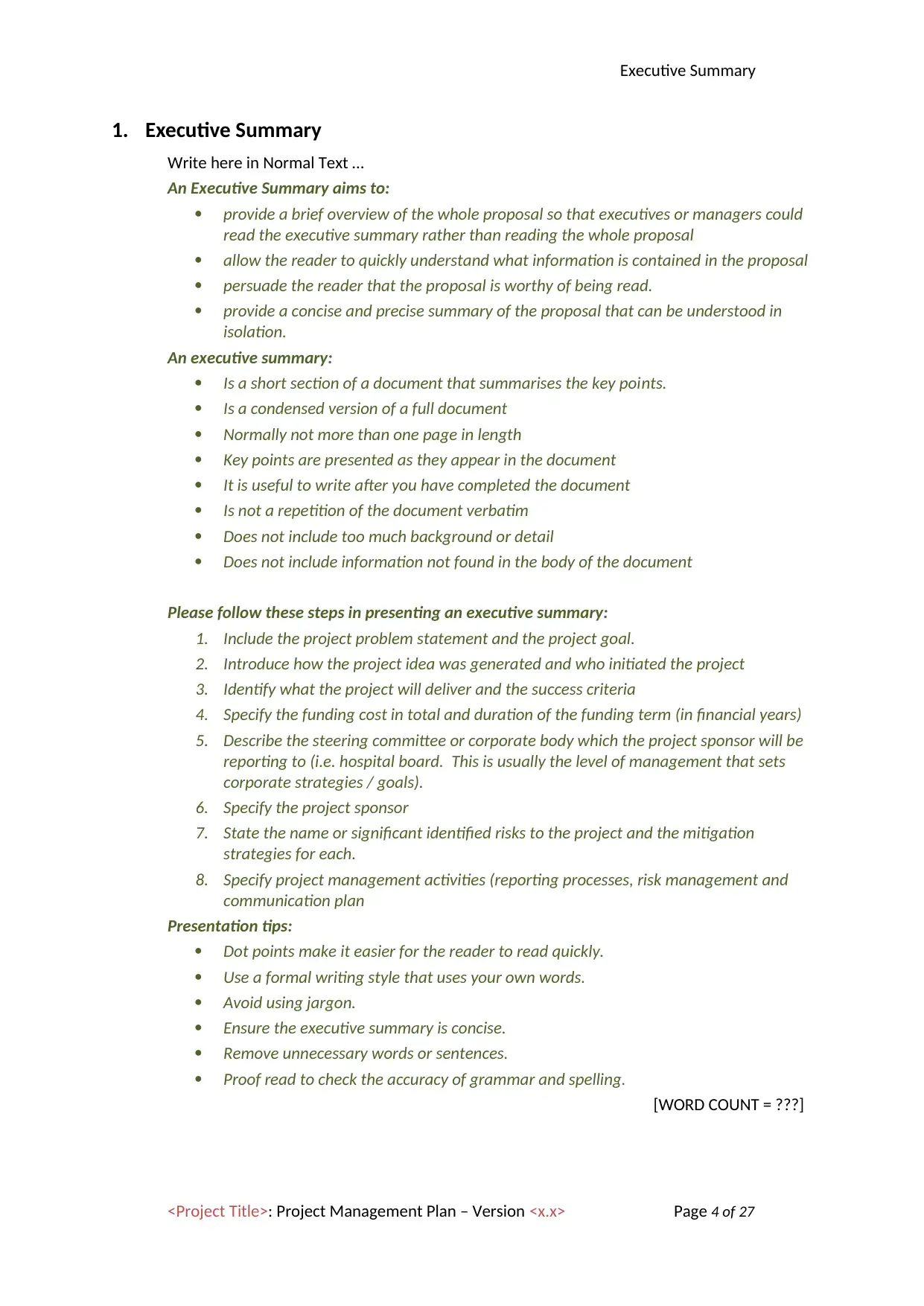
Executive Summary
1. Executive Summary
Write here in Normal Text …
An Executive Summary aims to:
provide a brief overview of the whole proposal so that executives or managers could
read the executive summary rather than reading the whole proposal
allow the reader to quickly understand what information is contained in the proposal
persuade the reader that the proposal is worthy of being read.
provide a concise and precise summary of the proposal that can be understood in
isolation.
An executive summary:
Is a short section of a document that summarises the key points.
Is a condensed version of a full document
Normally not more than one page in length
Key points are presented as they appear in the document
It is useful to write after you have completed the document
Is not a repetition of the document verbatim
Does not include too much background or detail
Does not include information not found in the body of the document
Please follow these steps in presenting an executive summary:
1. Include the project problem statement and the project goal.
2. Introduce how the project idea was generated and who initiated the project
3. Identify what the project will deliver and the success criteria
4. Specify the funding cost in total and duration of the funding term (in financial years)
5. Describe the steering committee or corporate body which the project sponsor will be
reporting to (i.e. hospital board. This is usually the level of management that sets
corporate strategies / goals).
6. Specify the project sponsor
7. State the name or significant identified risks to the project and the mitigation
strategies for each.
8. Specify project management activities (reporting processes, risk management and
communication plan
Presentation tips:
Dot points make it easier for the reader to read quickly.
Use a formal writing style that uses your own words.
Avoid using jargon.
Ensure the executive summary is concise.
Remove unnecessary words or sentences.
Proof read to check the accuracy of grammar and spelling.
[WORD COUNT = ???]
<Project Title>: Project Management Plan – Version <x.x> Page 4 of 27
1. Executive Summary
Write here in Normal Text …
An Executive Summary aims to:
provide a brief overview of the whole proposal so that executives or managers could
read the executive summary rather than reading the whole proposal
allow the reader to quickly understand what information is contained in the proposal
persuade the reader that the proposal is worthy of being read.
provide a concise and precise summary of the proposal that can be understood in
isolation.
An executive summary:
Is a short section of a document that summarises the key points.
Is a condensed version of a full document
Normally not more than one page in length
Key points are presented as they appear in the document
It is useful to write after you have completed the document
Is not a repetition of the document verbatim
Does not include too much background or detail
Does not include information not found in the body of the document
Please follow these steps in presenting an executive summary:
1. Include the project problem statement and the project goal.
2. Introduce how the project idea was generated and who initiated the project
3. Identify what the project will deliver and the success criteria
4. Specify the funding cost in total and duration of the funding term (in financial years)
5. Describe the steering committee or corporate body which the project sponsor will be
reporting to (i.e. hospital board. This is usually the level of management that sets
corporate strategies / goals).
6. Specify the project sponsor
7. State the name or significant identified risks to the project and the mitigation
strategies for each.
8. Specify project management activities (reporting processes, risk management and
communication plan
Presentation tips:
Dot points make it easier for the reader to read quickly.
Use a formal writing style that uses your own words.
Avoid using jargon.
Ensure the executive summary is concise.
Remove unnecessary words or sentences.
Proof read to check the accuracy of grammar and spelling.
[WORD COUNT = ???]
<Project Title>: Project Management Plan – Version <x.x> Page 4 of 27
⊘ This is a preview!⊘
Do you want full access?
Subscribe today to unlock all pages.

Trusted by 1+ million students worldwide
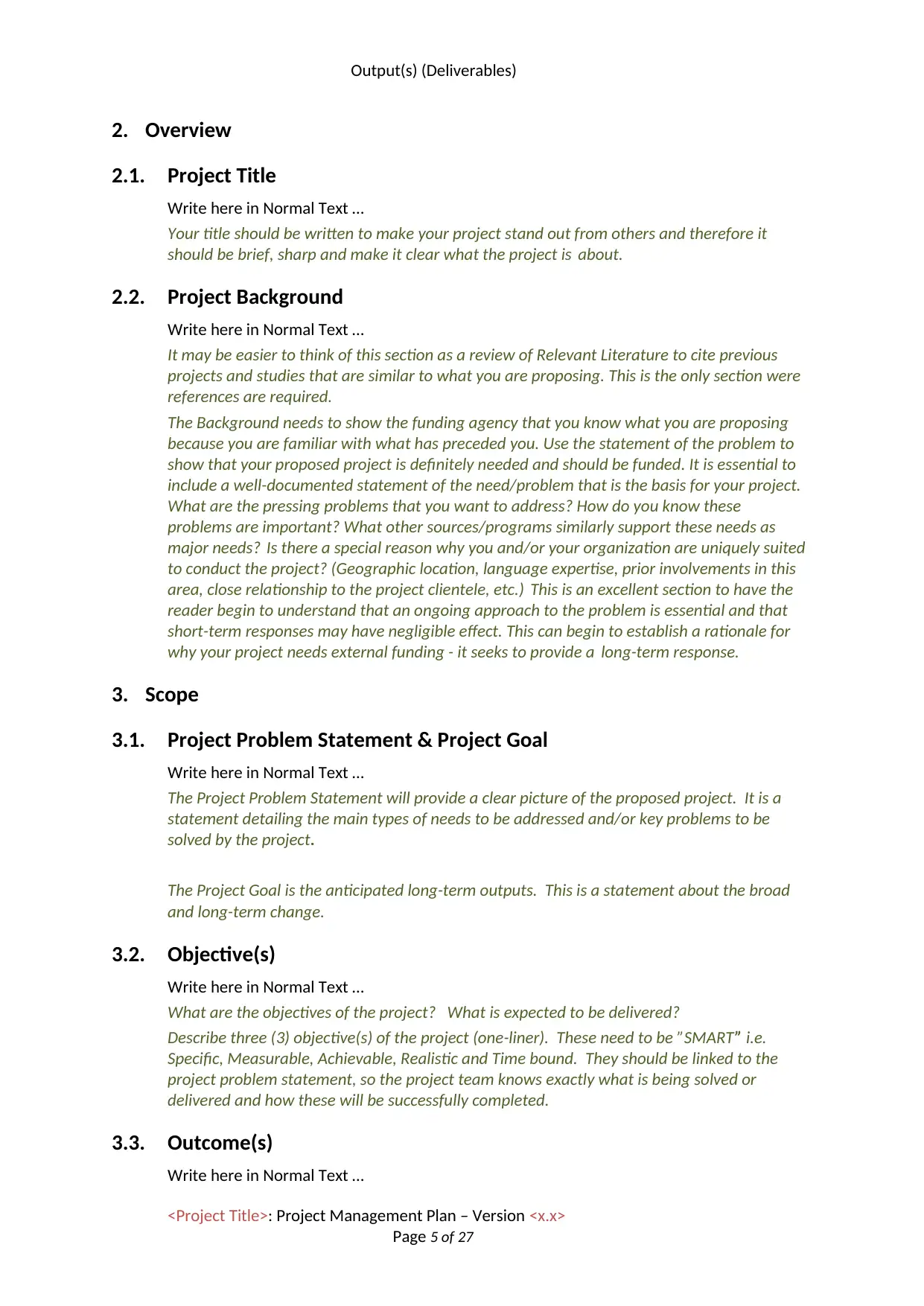
Output(s) (Deliverables)
2. Overview
2.1. Project Title
Write here in Normal Text …
Your title should be written to make your project stand out from others and therefore it
should be brief, sharp and make it clear what the project is about.
2.2. Project Background
Write here in Normal Text …
It may be easier to think of this section as a review of Relevant Literature to cite previous
projects and studies that are similar to what you are proposing. This is the only section were
references are required.
The Background needs to show the funding agency that you know what you are proposing
because you are familiar with what has preceded you. Use the statement of the problem to
show that your proposed project is definitely needed and should be funded. It is essential to
include a well-documented statement of the need/problem that is the basis for your project.
What are the pressing problems that you want to address? How do you know these
problems are important? What other sources/programs similarly support these needs as
major needs? Is there a special reason why you and/or your organization are uniquely suited
to conduct the project? (Geographic location, language expertise, prior involvements in this
area, close relationship to the project clientele, etc.) This is an excellent section to have the
reader begin to understand that an ongoing approach to the problem is essential and that
short-term responses may have negligible effect. This can begin to establish a rationale for
why your project needs external funding - it seeks to provide a long-term response.
3. Scope
3.1. Project Problem Statement & Project Goal
Write here in Normal Text …
The Project Problem Statement will provide a clear picture of the proposed project. It is a
statement detailing the main types of needs to be addressed and/or key problems to be
solved by the project.
The Project Goal is the anticipated long-term outputs. This is a statement about the broad
and long-term change.
3.2. Objective(s)
Write here in Normal Text …
What are the objectives of the project? What is expected to be delivered?
Describe three (3) objective(s) of the project (one-liner). These need to be ”SMART” i.e.
Specific, Measurable, Achievable, Realistic and Time bound. They should be linked to the
project problem statement, so the project team knows exactly what is being solved or
delivered and how these will be successfully completed.
3.3. Outcome(s)
Write here in Normal Text …
<Project Title>: Project Management Plan – Version <x.x>
Page 5 of 27
2. Overview
2.1. Project Title
Write here in Normal Text …
Your title should be written to make your project stand out from others and therefore it
should be brief, sharp and make it clear what the project is about.
2.2. Project Background
Write here in Normal Text …
It may be easier to think of this section as a review of Relevant Literature to cite previous
projects and studies that are similar to what you are proposing. This is the only section were
references are required.
The Background needs to show the funding agency that you know what you are proposing
because you are familiar with what has preceded you. Use the statement of the problem to
show that your proposed project is definitely needed and should be funded. It is essential to
include a well-documented statement of the need/problem that is the basis for your project.
What are the pressing problems that you want to address? How do you know these
problems are important? What other sources/programs similarly support these needs as
major needs? Is there a special reason why you and/or your organization are uniquely suited
to conduct the project? (Geographic location, language expertise, prior involvements in this
area, close relationship to the project clientele, etc.) This is an excellent section to have the
reader begin to understand that an ongoing approach to the problem is essential and that
short-term responses may have negligible effect. This can begin to establish a rationale for
why your project needs external funding - it seeks to provide a long-term response.
3. Scope
3.1. Project Problem Statement & Project Goal
Write here in Normal Text …
The Project Problem Statement will provide a clear picture of the proposed project. It is a
statement detailing the main types of needs to be addressed and/or key problems to be
solved by the project.
The Project Goal is the anticipated long-term outputs. This is a statement about the broad
and long-term change.
3.2. Objective(s)
Write here in Normal Text …
What are the objectives of the project? What is expected to be delivered?
Describe three (3) objective(s) of the project (one-liner). These need to be ”SMART” i.e.
Specific, Measurable, Achievable, Realistic and Time bound. They should be linked to the
project problem statement, so the project team knows exactly what is being solved or
delivered and how these will be successfully completed.
3.3. Outcome(s)
Write here in Normal Text …
<Project Title>: Project Management Plan – Version <x.x>
Page 5 of 27
Paraphrase This Document
Need a fresh take? Get an instant paraphrase of this document with our AI Paraphraser
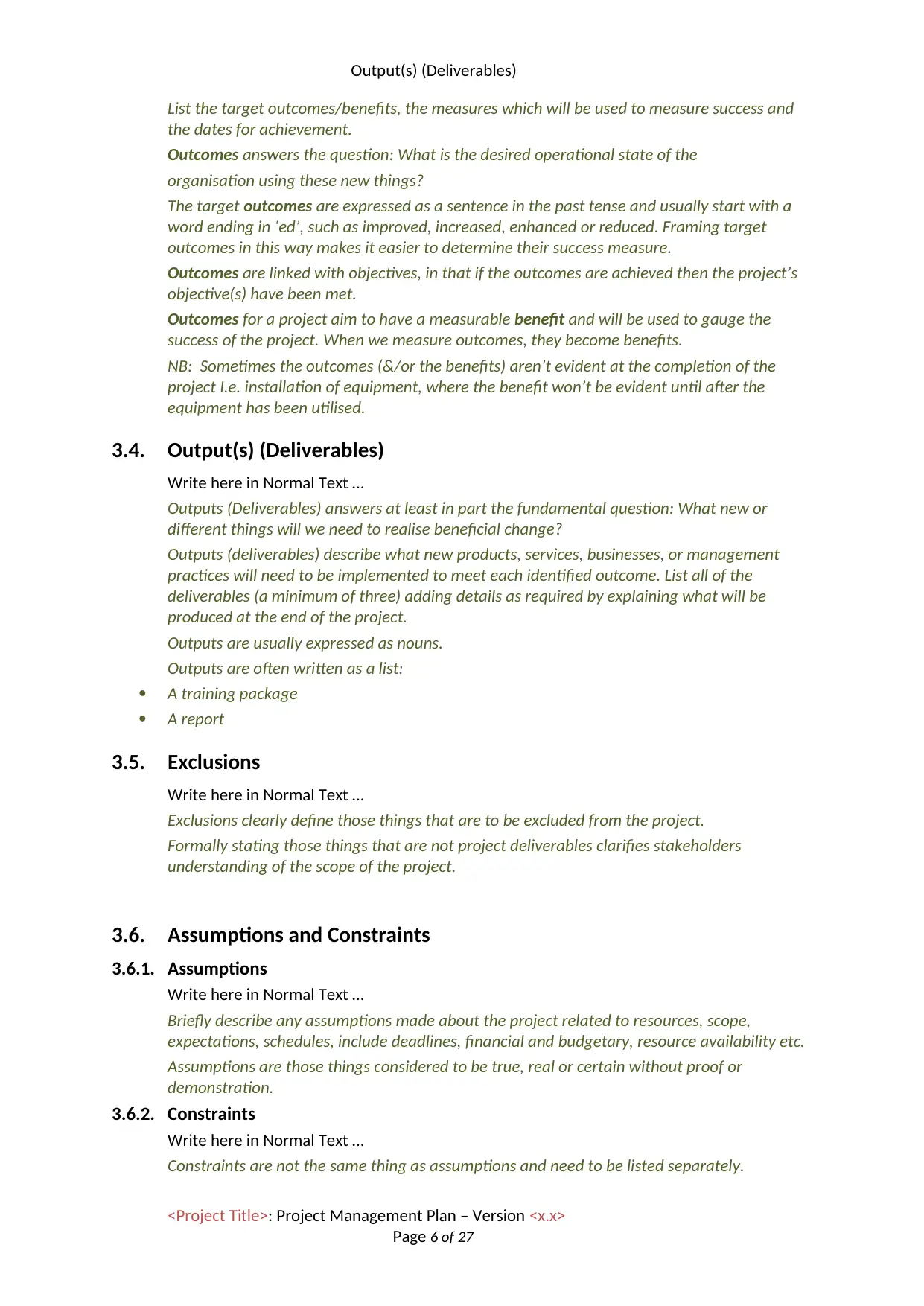
Output(s) (Deliverables)
List the target outcomes/benefits, the measures which will be used to measure success and
the dates for achievement.
Outcomes answers the question: What is the desired operational state of the
organisation using these new things?
The target outcomes are expressed as a sentence in the past tense and usually start with a
word ending in ‘ed’, such as improved, increased, enhanced or reduced. Framing target
outcomes in this way makes it easier to determine their success measure.
Outcomes are linked with objectives, in that if the outcomes are achieved then the project’s
objective(s) have been met.
Outcomes for a project aim to have a measurable benefit and will be used to gauge the
success of the project. When we measure outcomes, they become benefits.
NB: Sometimes the outcomes (&/or the benefits) aren’t evident at the completion of the
project I.e. installation of equipment, where the benefit won’t be evident until after the
equipment has been utilised.
3.4. Output(s) (Deliverables)
Write here in Normal Text …
Outputs (Deliverables) answers at least in part the fundamental question: What new or
different things will we need to realise beneficial change?
Outputs (deliverables) describe what new products, services, businesses, or management
practices will need to be implemented to meet each identified outcome. List all of the
deliverables (a minimum of three) adding details as required by explaining what will be
produced at the end of the project.
Outputs are usually expressed as nouns.
Outputs are often written as a list:
A training package
A report
3.5. Exclusions
Write here in Normal Text …
Exclusions clearly define those things that are to be excluded from the project.
Formally stating those things that are not project deliverables clarifies stakeholders
understanding of the scope of the project.
3.6. Assumptions and Constraints
3.6.1. Assumptions
Write here in Normal Text …
Briefly describe any assumptions made about the project related to resources, scope,
expectations, schedules, include deadlines, financial and budgetary, resource availability etc.
Assumptions are those things considered to be true, real or certain without proof or
demonstration.
3.6.2. Constraints
Write here in Normal Text …
Constraints are not the same thing as assumptions and need to be listed separately.
<Project Title>: Project Management Plan – Version <x.x>
Page 6 of 27
List the target outcomes/benefits, the measures which will be used to measure success and
the dates for achievement.
Outcomes answers the question: What is the desired operational state of the
organisation using these new things?
The target outcomes are expressed as a sentence in the past tense and usually start with a
word ending in ‘ed’, such as improved, increased, enhanced or reduced. Framing target
outcomes in this way makes it easier to determine their success measure.
Outcomes are linked with objectives, in that if the outcomes are achieved then the project’s
objective(s) have been met.
Outcomes for a project aim to have a measurable benefit and will be used to gauge the
success of the project. When we measure outcomes, they become benefits.
NB: Sometimes the outcomes (&/or the benefits) aren’t evident at the completion of the
project I.e. installation of equipment, where the benefit won’t be evident until after the
equipment has been utilised.
3.4. Output(s) (Deliverables)
Write here in Normal Text …
Outputs (Deliverables) answers at least in part the fundamental question: What new or
different things will we need to realise beneficial change?
Outputs (deliverables) describe what new products, services, businesses, or management
practices will need to be implemented to meet each identified outcome. List all of the
deliverables (a minimum of three) adding details as required by explaining what will be
produced at the end of the project.
Outputs are usually expressed as nouns.
Outputs are often written as a list:
A training package
A report
3.5. Exclusions
Write here in Normal Text …
Exclusions clearly define those things that are to be excluded from the project.
Formally stating those things that are not project deliverables clarifies stakeholders
understanding of the scope of the project.
3.6. Assumptions and Constraints
3.6.1. Assumptions
Write here in Normal Text …
Briefly describe any assumptions made about the project related to resources, scope,
expectations, schedules, include deadlines, financial and budgetary, resource availability etc.
Assumptions are those things considered to be true, real or certain without proof or
demonstration.
3.6.2. Constraints
Write here in Normal Text …
Constraints are not the same thing as assumptions and need to be listed separately.
<Project Title>: Project Management Plan – Version <x.x>
Page 6 of 27
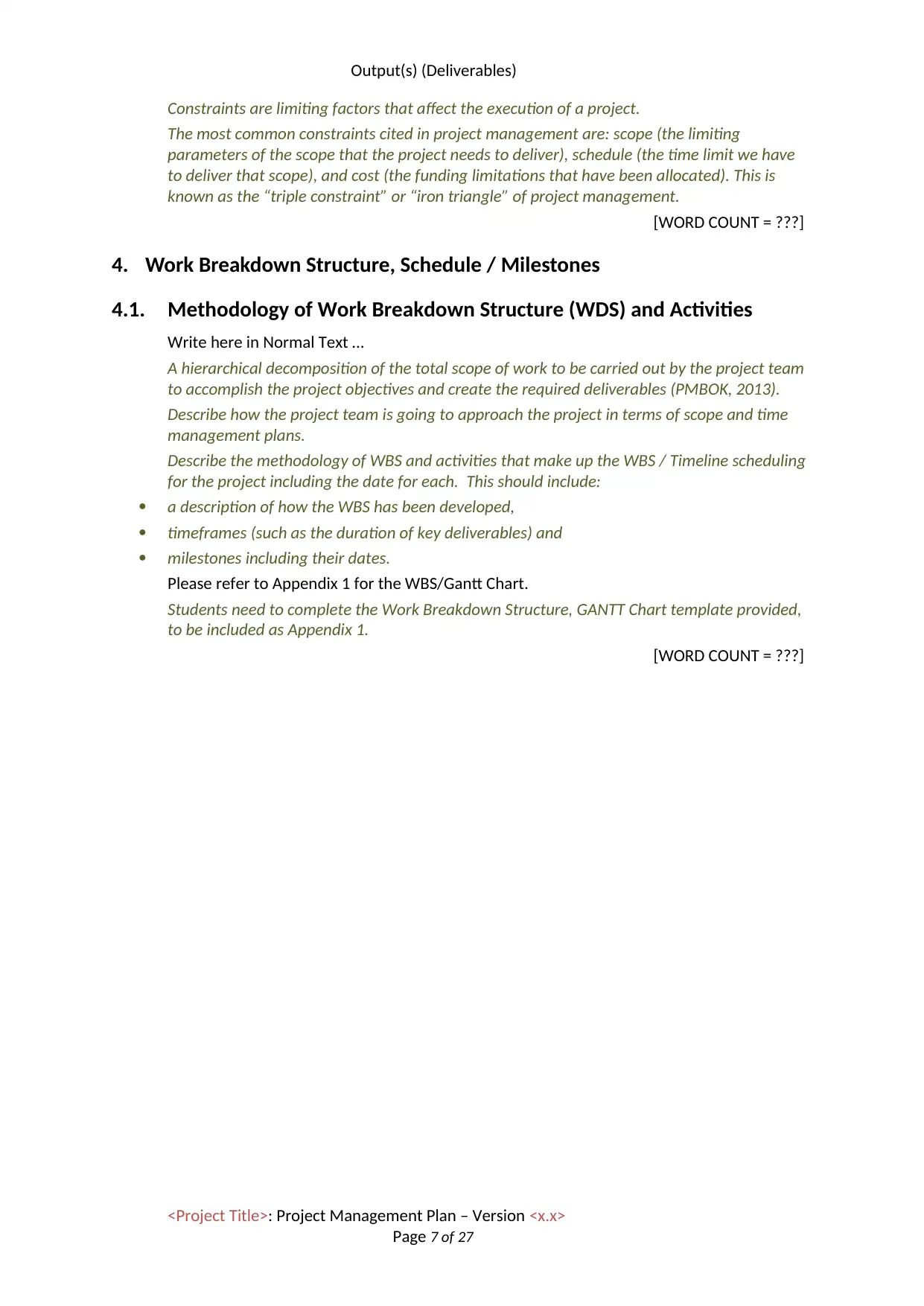
Output(s) (Deliverables)
Constraints are limiting factors that affect the execution of a project.
The most common constraints cited in project management are: scope (the limiting
parameters of the scope that the project needs to deliver), schedule (the time limit we have
to deliver that scope), and cost (the funding limitations that have been allocated). This is
known as the “triple constraint” or “iron triangle” of project management.
[WORD COUNT = ???]
4. Work Breakdown Structure, Schedule / Milestones
4.1. Methodology of Work Breakdown Structure (WDS) and Activities
Write here in Normal Text …
A hierarchical decomposition of the total scope of work to be carried out by the project team
to accomplish the project objectives and create the required deliverables (PMBOK, 2013).
Describe how the project team is going to approach the project in terms of scope and time
management plans.
Describe the methodology of WBS and activities that make up the WBS / Timeline scheduling
for the project including the date for each. This should include:
a description of how the WBS has been developed,
timeframes (such as the duration of key deliverables) and
milestones including their dates.
Please refer to Appendix 1 for the WBS/Gantt Chart.
Students need to complete the Work Breakdown Structure, GANTT Chart template provided,
to be included as Appendix 1.
[WORD COUNT = ???]
<Project Title>: Project Management Plan – Version <x.x>
Page 7 of 27
Constraints are limiting factors that affect the execution of a project.
The most common constraints cited in project management are: scope (the limiting
parameters of the scope that the project needs to deliver), schedule (the time limit we have
to deliver that scope), and cost (the funding limitations that have been allocated). This is
known as the “triple constraint” or “iron triangle” of project management.
[WORD COUNT = ???]
4. Work Breakdown Structure, Schedule / Milestones
4.1. Methodology of Work Breakdown Structure (WDS) and Activities
Write here in Normal Text …
A hierarchical decomposition of the total scope of work to be carried out by the project team
to accomplish the project objectives and create the required deliverables (PMBOK, 2013).
Describe how the project team is going to approach the project in terms of scope and time
management plans.
Describe the methodology of WBS and activities that make up the WBS / Timeline scheduling
for the project including the date for each. This should include:
a description of how the WBS has been developed,
timeframes (such as the duration of key deliverables) and
milestones including their dates.
Please refer to Appendix 1 for the WBS/Gantt Chart.
Students need to complete the Work Breakdown Structure, GANTT Chart template provided,
to be included as Appendix 1.
[WORD COUNT = ???]
<Project Title>: Project Management Plan – Version <x.x>
Page 7 of 27
⊘ This is a preview!⊘
Do you want full access?
Subscribe today to unlock all pages.

Trusted by 1+ million students worldwide
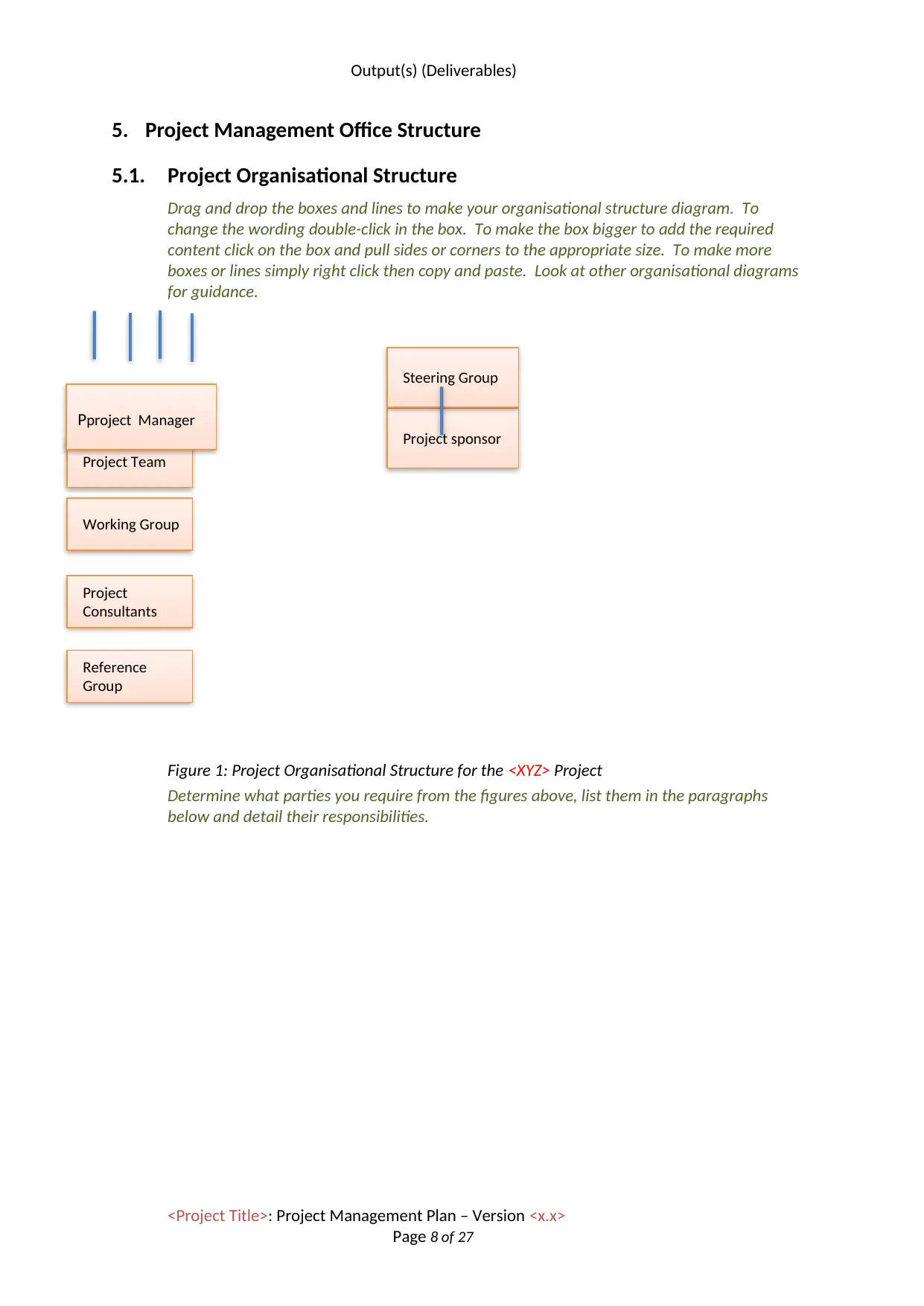
Output(s) (Deliverables)
5. Project Management Office Structure
5.1. Project Organisational Structure
Drag and drop the boxes and lines to make your organisational structure diagram. To
change the wording double-click in the box. To make the box bigger to add the required
content click on the box and pull sides or corners to the appropriate size. To make more
boxes or lines simply right click then copy and paste. Look at other organisational diagrams
for guidance.
Figure 1: Project Organisational Structure for the <XYZ> Project
Determine what parties you require from the figures above, list them in the paragraphs
below and detail their responsibilities.
<Project Title>: Project Management Plan – Version <x.x>
Page 8 of 27
Project sponsor
Project Team
Reference
Group
Pproject Manager
Working Group
Steering Group
Project
Consultants
5. Project Management Office Structure
5.1. Project Organisational Structure
Drag and drop the boxes and lines to make your organisational structure diagram. To
change the wording double-click in the box. To make the box bigger to add the required
content click on the box and pull sides or corners to the appropriate size. To make more
boxes or lines simply right click then copy and paste. Look at other organisational diagrams
for guidance.
Figure 1: Project Organisational Structure for the <XYZ> Project
Determine what parties you require from the figures above, list them in the paragraphs
below and detail their responsibilities.
<Project Title>: Project Management Plan – Version <x.x>
Page 8 of 27
Project sponsor
Project Team
Reference
Group
Pproject Manager
Working Group
Steering Group
Project
Consultants
Paraphrase This Document
Need a fresh take? Get an instant paraphrase of this document with our AI Paraphraser
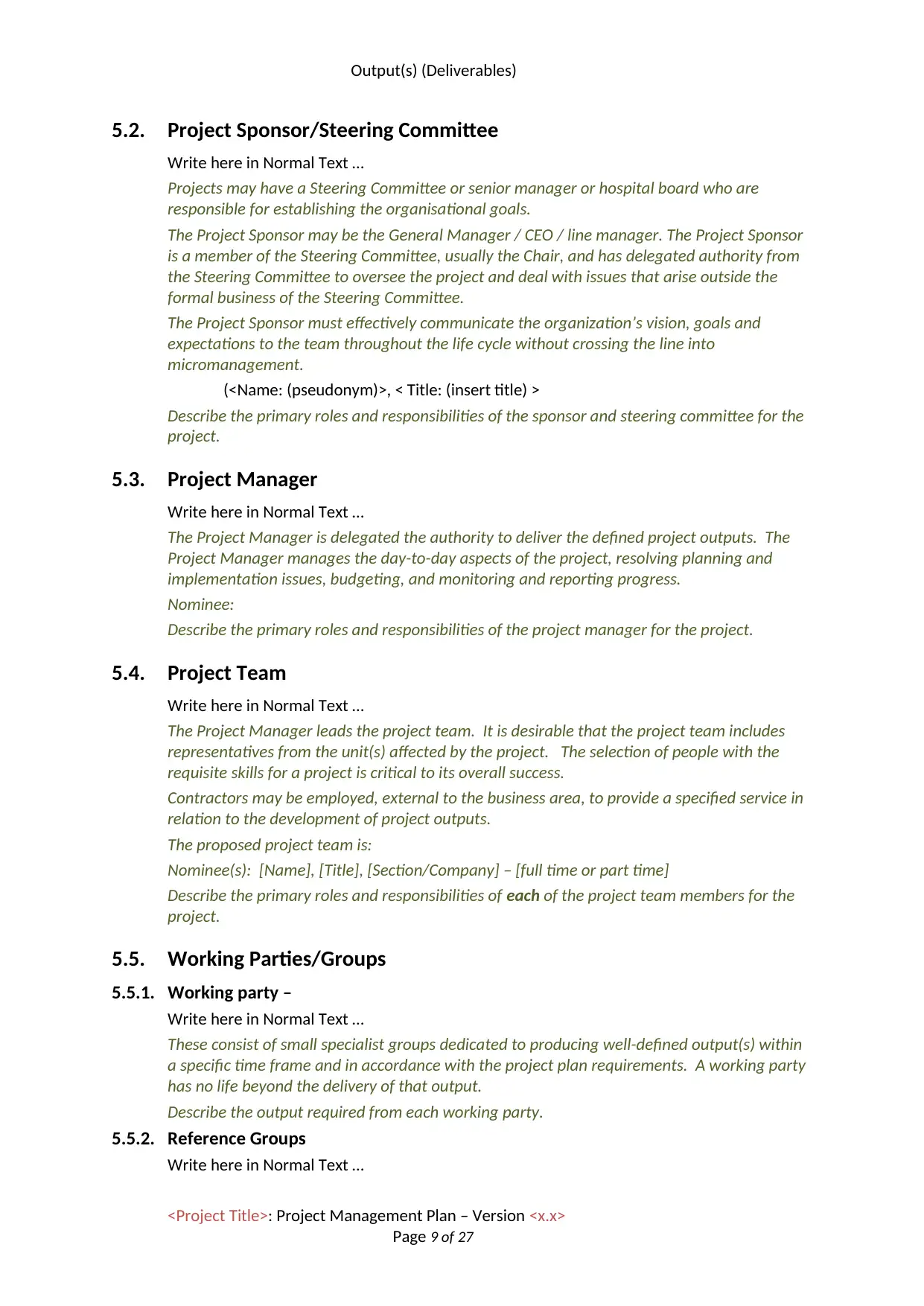
Output(s) (Deliverables)
5.2. Project Sponsor/Steering Committee
Write here in Normal Text …
Projects may have a Steering Committee or senior manager or hospital board who are
responsible for establishing the organisational goals.
The Project Sponsor may be the General Manager / CEO / line manager. The Project Sponsor
is a member of the Steering Committee, usually the Chair, and has delegated authority from
the Steering Committee to oversee the project and deal with issues that arise outside the
formal business of the Steering Committee.
The Project Sponsor must effectively communicate the organization’s vision, goals and
expectations to the team throughout the life cycle without crossing the line into
micromanagement.
(<Name: (pseudonym)>, < Title: (insert title) >
Describe the primary roles and responsibilities of the sponsor and steering committee for the
project.
5.3. Project Manager
Write here in Normal Text …
The Project Manager is delegated the authority to deliver the defined project outputs. The
Project Manager manages the day-to-day aspects of the project, resolving planning and
implementation issues, budgeting, and monitoring and reporting progress.
Nominee:
Describe the primary roles and responsibilities of the project manager for the project.
5.4. Project Team
Write here in Normal Text …
The Project Manager leads the project team. It is desirable that the project team includes
representatives from the unit(s) affected by the project. The selection of people with the
requisite skills for a project is critical to its overall success.
Contractors may be employed, external to the business area, to provide a specified service in
relation to the development of project outputs.
The proposed project team is:
Nominee(s): [Name], [Title], [Section/Company] – [full time or part time]
Describe the primary roles and responsibilities of each of the project team members for the
project.
5.5. Working Parties/Groups
5.5.1. Working party –
Write here in Normal Text …
These consist of small specialist groups dedicated to producing well-defined output(s) within
a specific time frame and in accordance with the project plan requirements. A working party
has no life beyond the delivery of that output.
Describe the output required from each working party.
5.5.2. Reference Groups
Write here in Normal Text …
<Project Title>: Project Management Plan – Version <x.x>
Page 9 of 27
5.2. Project Sponsor/Steering Committee
Write here in Normal Text …
Projects may have a Steering Committee or senior manager or hospital board who are
responsible for establishing the organisational goals.
The Project Sponsor may be the General Manager / CEO / line manager. The Project Sponsor
is a member of the Steering Committee, usually the Chair, and has delegated authority from
the Steering Committee to oversee the project and deal with issues that arise outside the
formal business of the Steering Committee.
The Project Sponsor must effectively communicate the organization’s vision, goals and
expectations to the team throughout the life cycle without crossing the line into
micromanagement.
(<Name: (pseudonym)>, < Title: (insert title) >
Describe the primary roles and responsibilities of the sponsor and steering committee for the
project.
5.3. Project Manager
Write here in Normal Text …
The Project Manager is delegated the authority to deliver the defined project outputs. The
Project Manager manages the day-to-day aspects of the project, resolving planning and
implementation issues, budgeting, and monitoring and reporting progress.
Nominee:
Describe the primary roles and responsibilities of the project manager for the project.
5.4. Project Team
Write here in Normal Text …
The Project Manager leads the project team. It is desirable that the project team includes
representatives from the unit(s) affected by the project. The selection of people with the
requisite skills for a project is critical to its overall success.
Contractors may be employed, external to the business area, to provide a specified service in
relation to the development of project outputs.
The proposed project team is:
Nominee(s): [Name], [Title], [Section/Company] – [full time or part time]
Describe the primary roles and responsibilities of each of the project team members for the
project.
5.5. Working Parties/Groups
5.5.1. Working party –
Write here in Normal Text …
These consist of small specialist groups dedicated to producing well-defined output(s) within
a specific time frame and in accordance with the project plan requirements. A working party
has no life beyond the delivery of that output.
Describe the output required from each working party.
5.5.2. Reference Groups
Write here in Normal Text …
<Project Title>: Project Management Plan – Version <x.x>
Page 9 of 27
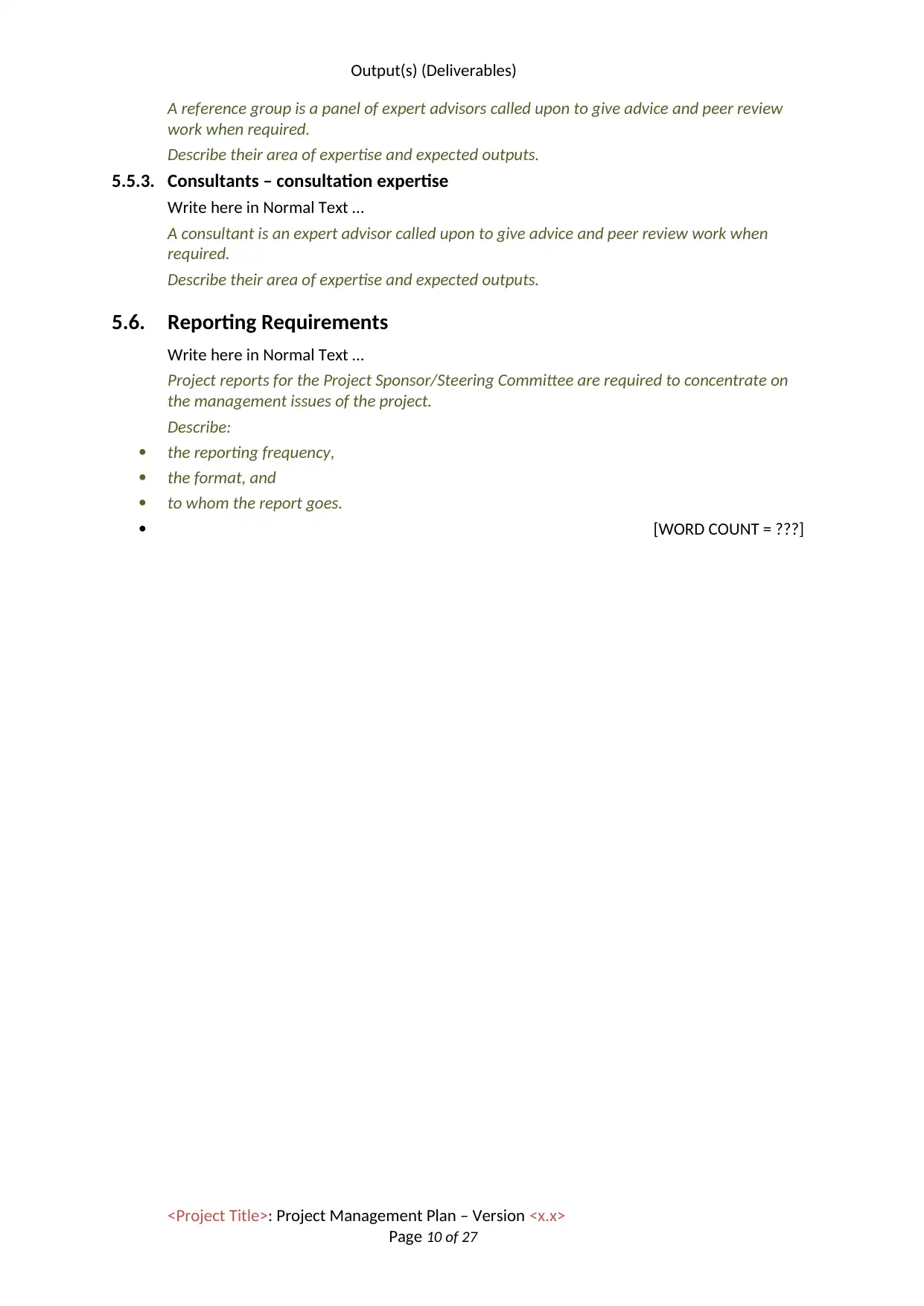
Output(s) (Deliverables)
A reference group is a panel of expert advisors called upon to give advice and peer review
work when required.
Describe their area of expertise and expected outputs.
5.5.3. Consultants – consultation expertise
Write here in Normal Text …
A consultant is an expert advisor called upon to give advice and peer review work when
required.
Describe their area of expertise and expected outputs.
5.6. Reporting Requirements
Write here in Normal Text …
Project reports for the Project Sponsor/Steering Committee are required to concentrate on
the management issues of the project.
Describe:
the reporting frequency,
the format, and
to whom the report goes.
[WORD COUNT = ???]
<Project Title>: Project Management Plan – Version <x.x>
Page 10 of 27
A reference group is a panel of expert advisors called upon to give advice and peer review
work when required.
Describe their area of expertise and expected outputs.
5.5.3. Consultants – consultation expertise
Write here in Normal Text …
A consultant is an expert advisor called upon to give advice and peer review work when
required.
Describe their area of expertise and expected outputs.
5.6. Reporting Requirements
Write here in Normal Text …
Project reports for the Project Sponsor/Steering Committee are required to concentrate on
the management issues of the project.
Describe:
the reporting frequency,
the format, and
to whom the report goes.
[WORD COUNT = ???]
<Project Title>: Project Management Plan – Version <x.x>
Page 10 of 27
⊘ This is a preview!⊘
Do you want full access?
Subscribe today to unlock all pages.

Trusted by 1+ million students worldwide
1 out of 26
Related Documents
Your All-in-One AI-Powered Toolkit for Academic Success.
+13062052269
info@desklib.com
Available 24*7 on WhatsApp / Email
![[object Object]](/_next/static/media/star-bottom.7253800d.svg)
Unlock your academic potential
Copyright © 2020–2025 A2Z Services. All Rights Reserved. Developed and managed by ZUCOL.





